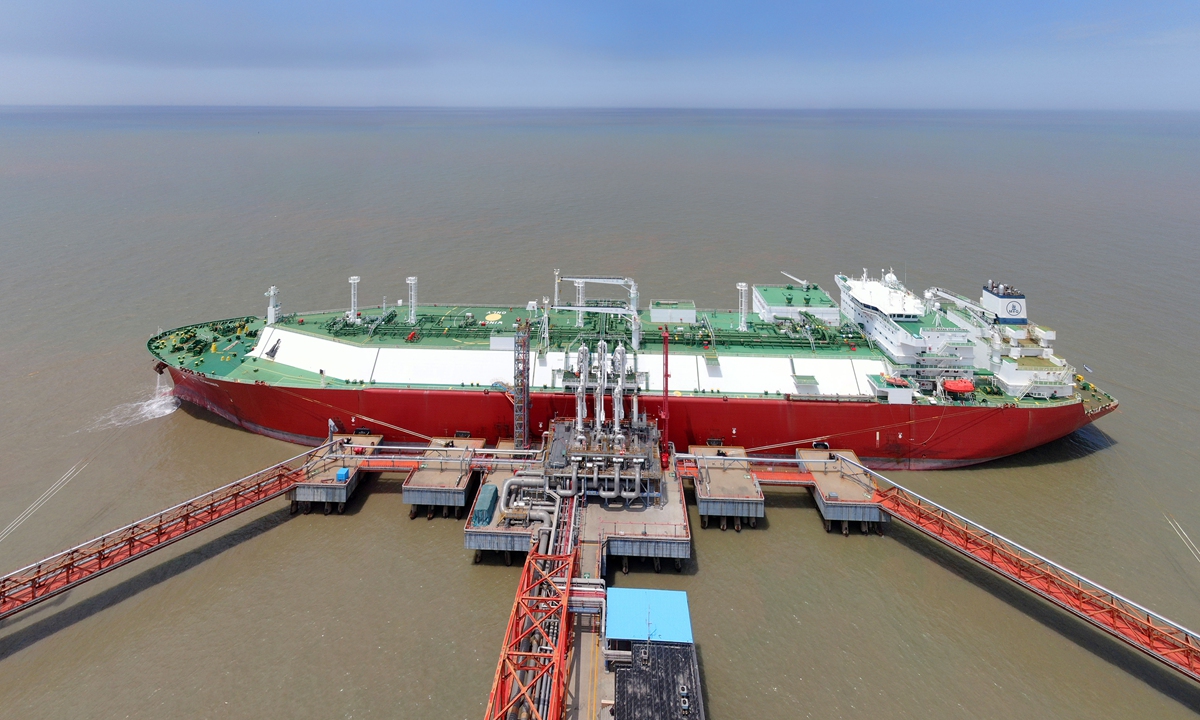
A liquefied natural gas (LNG) receiving terminal at Yangkou Port in Nantong, East China's Jiangsu Province is busy unloading imported LNG over the weekend. Since May 17, the terminal has unloaded LNG totaling 400,000 tons from six containerships, a record high. Photo: cnsphoto
Runaway natural gas prices worldwide, driven by peak demand, an economic recovery from the COVID-19 pandemic and US' loose monetary policy, will inflate Chinese natural gas prices, industry experts warned on Sunday.
However, the impact will unlikely be as bad as that of surging iron ore prices due to China's more diversified import sources and the prevalence of long-term contracts, experts noted.
US natural gas futures, Asian liquefied natural gas (LNG) prices and European natural gas prices have all been rising aggressively since June, promoting media outlets to declare the era of cheap natural gas is over.
East Asia, Europe and the US are the biggest natural gas consumers.
In the first half of 2021, China's natural gas imports reached 59.82 million tons, up 23.8 percent from the corresponding period last year. The import value rose 9.5 percent to 136.24 billion yuan ($20.95 billion), according to official data.
A research note by industry portal chem365.net said that much of the increase came from LNG and the average price of LNG imports rose 39 percent year-on-year, citing its survey of China's LNG receiving facilities.
Chinese energy experts and analysts warned that the inflated global price for natural gas, mostly for spot LNG, will inflate domestic gas prices, meaning higher costs for China's industries.
But they said China is unlikely to face the same impact as that caused by rising iron ore prices this year.
Iron ore prices have hit the highest levels in a decade this year, prompting the Chinese government to take multiple measures to support the manufacturing industry and cushion the impact amid an economic recovery from the virus-induced lockdowns.
Wang Ruiqi, a gas analyst at domestic commodities information website 315i.com, said the rising spot price of LNG in major global consumption markets will curb supplies in China and push up prices. This will cause prices in industries, including ceramics, metallurgy, glass and dried fruits, to rise.
But Wang added that a large portion of LNG supply is purchased under long-term contracts and is less likely to be affected by the current volatile spot prices.
LNG accounted for 60 percent of China's gas use in 2020 while piped gas supplies, whose prices are more stable, accounted for the rest. Natural gas has been a preferred alternative in the energy mix of China, which is pursuing greener growth and an ambitious climate agenda.
In 2020, China's natural gas imports totaled 101.66 million tons, increasing 5.3 percent year-on-year, customs data showed. Prices for natural gas imports plunged 19.4 percent year-on-year to 231.49 billion yuan, due to dampened demand as the pandemic hit the world economy.
China is on the way to become the world's largest LNG market in 2021, according to a report by Wood Mackenzie.
Wang predicted that there will be a 20 percent rise in the import volume of LNG this year, on top of rising LNG prices "to a certain extent."
However, Jin Lei, an associate professor at the Beijing-based China University of Petroleum, said that although China's natural gas consumption is expanding at a faster rate than global economies and there has been a rapid global LNG price since June, China is unlikely to face a serious impact like that of iron ore.
"Natural gas, unlike iron ore, cannot be stored so easily, so the sellers are less likely to abuse the buyer," Jin told the Global Times on Sunday, adding that LNG imports could be further boosted if extreme weather and a faster-than-expected recovery happened in the second half.
Unlike iron ore, China's LNG import sources are diversified, with 24 exporting countries involved as of 2020, according to media reports. Australia provided 46 percent of the LNG imports. Qatar was the second-largest source, followed by Malaysia and Indonesia.
The top five pipeline natural gas exporters to China are Turkmenistan, Uzbekistan, Kazakhstan, Myanmar and Russia.
Nonetheless, Jin noted that current price volatility shows merits of long-term supply contracts. Pipelines are still operating at low capacity, and imports through pipelines linking Russia, Myanmar and Central Asian countries should be increased to balance the growing weight of LNG imports in China, he said.




